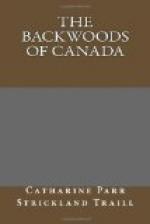Row 8
Column 1: 1830
Column 2: 6,400
Column 3: 12,500
Column 4: 12,600
Column 5: 9,336
Column 6: 27,400
Column 7: 68,236
Row 9
Column 1: 1831
Column 2: 5,500
Column 3: 58,400
Column 4: 7,200
Column 5: 8,000
Column 6: 34,200
Column 7: 113,300
Row 10
Column 1: 1832
Column 2: 19,300
Column 3: 97,800
Column 4: 7,600
Column 5: 6,100
Column 6: 62,600
Column 7: 193,400
Row 11
Column 1: 1833
Column 2: 35,200
Column 3: 46,000
Column 4: —
Column 5: 9,100
Column 6: 135,600
Column 7: 225,900
Row 12
Column 1: Totals
Column 2: 142,100
Column 3: 241,900
Column 4: 64,300
Column 5: 376,620
Column 6: 433,400
Column 7: 1,258,320
Condition. — Actual settlement.
* U.E. Loyalists means United English Loyalists—individuals who fled from the United States on the breaking out of the American war of independence. The grants in the above column are mostly to the children of these individuals.
---------------------------------------
The conditions in force in 1824, the time from which the Returns take their commencement, were enacted by Orders in Council of 20th October, 1818, and 21st February, 1820, applied equally to all classes of grantees, and were as follows:—
“That locatees shall clear thoroughly and fence five acres for every 100 acres granted; and build a house 16 feet by 20 in the clear; and to clear one-half of the road, and chop down, without charring, one chain in depth across the lot next to road. These road duties to be considered as part of the five acres per 100. The whole to be completed within two years from date of the location, and upon proof of their fulfilment patents to issue.
“On the 14th of May, 1830, an additional stipulation was made in locations to discharged soldiers, which required an actual residence on their lots, in person, for five years before the issue of their patents.
“On the 14th of November, 1830, the then existing Orders in Council, respecting settlement duties, were cancelled, and it was ordered that in lieu thereof each locatee should clear half the road in front of his lot, and from 10 feet in the centre of the road cut the stumps so low that waggon wheels might pass over them. Upon proof of this, and that a settler had been resident on the lot two years, a patent might issue. Locatees, however, were at liberty, instead of placing settlers on their lands, to clear, in addition to half the road on each lot, a chain in depth across the front, and to sow it and the road with grass seed.
“Upon discharged soldiers and seamen alone, under this order, it became imperative to reside on and improve their lands three years before the issue of the patent.
“On the 24th of May, 1832, an Order in Council was made, abolishing, in all cases except that of discharged soldiers and seamen, the regulations previously existing; and which directed that, upon proof of an actual settler being established on a lot, a patent should issue without the condition of settlement duty.”




